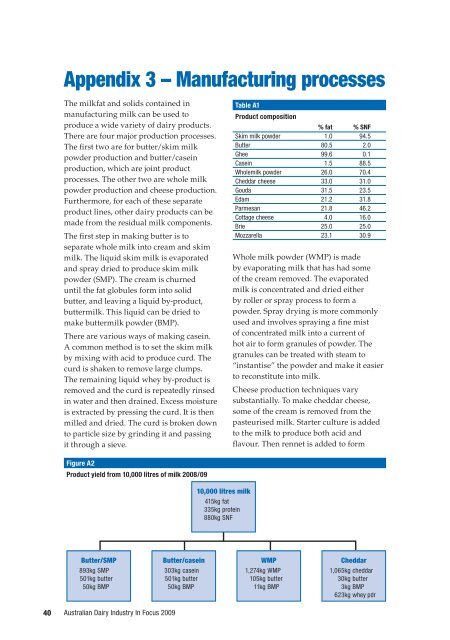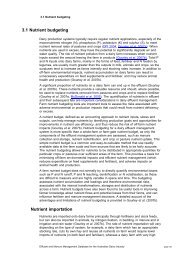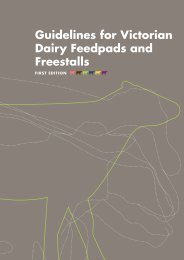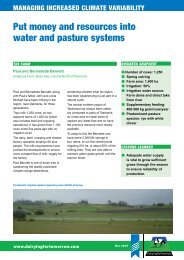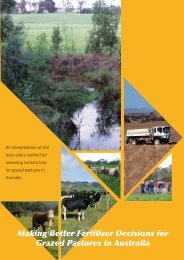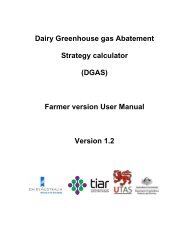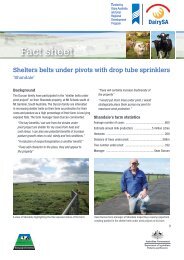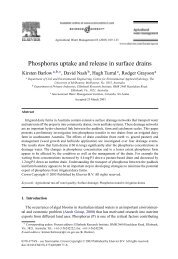Australian Dairy Industry In Focus 2009 - Dairying For Tomorrow
Australian Dairy Industry In Focus 2009 - Dairying For Tomorrow
Australian Dairy Industry In Focus 2009 - Dairying For Tomorrow
You also want an ePaper? Increase the reach of your titles
YUMPU automatically turns print PDFs into web optimized ePapers that Google loves.
Appendix 3 – Manufacturing processes<br />
The milkfat and solids contained in<br />
manufacturing milk can be used to<br />
produce a wide variety of dairy products.<br />
There are four major production processes.<br />
The first two are for butter/skim milk<br />
powder production and butter/casein<br />
production, which are joint product<br />
processes. The other two are whole milk<br />
powder production and cheese production.<br />
Furthermore, for each of these separate<br />
product lines, other dairy products can be<br />
made from the residual milk components.<br />
The first step in making butter is to<br />
separate whole milk into cream and skim<br />
milk. The liquid skim milk is evaporated<br />
and spray dried to produce skim milk<br />
powder (SMP). The cream is churned<br />
until the fat globules form into solid<br />
butter, and leaving a liquid by-product,<br />
buttermilk. This liquid can be dried to<br />
make buttermilk powder (BMP).<br />
There are various ways of making casein.<br />
A common method is to set the skim milk<br />
by mixing with acid to produce curd. The<br />
curd is shaken to remove large clumps.<br />
The remaining liquid whey by-product is<br />
removed and the curd is repeatedly rinsed<br />
in water and then drained. Excess moisture<br />
is extracted by pressing the curd. It is then<br />
milled and dried. The curd is broken down<br />
to particle size by grinding it and passing<br />
it through a sieve.<br />
Table A1<br />
Product composition<br />
% fat % SNF<br />
Skim milk powder 1.0 94.5<br />
Butter 80.5 2.0<br />
Ghee 99.6 0.1<br />
Casein 1.5 88.5<br />
Wholemilk powder 26.0 70.4<br />
Cheddar cheese 33.0 31.0<br />
Gouda 31.5 23.5<br />
Edam 21.2 31.8<br />
Parmesan 21.8 46.2<br />
Cottage cheese 4.0 16.0<br />
Brie 25.0 25.0<br />
Mozzarella 23.1 30.9<br />
Whole milk powder (WMP) is made<br />
by evaporating milk that has had some<br />
of the cream removed. The evaporated<br />
milk is concentrated and dried either<br />
by roller or spray process to form a<br />
powder. Spray drying is more commonly<br />
used and involves spraying a fine mist<br />
of concentrated milk into a current of<br />
hot air to form granules of powder. The<br />
granules can be treated with steam to<br />
“instantise” the powder and make it easier<br />
to reconstitute into milk.<br />
Cheese production techniques vary<br />
substantially. To make cheddar cheese,<br />
some of the cream is removed from the<br />
pasteurised milk. Starter culture is added<br />
to the milk to produce both acid and<br />
flavour. Then rennet is added to form<br />
Figure A2<br />
Product yield from 10,000 litres of milk 2008/09<br />
10,000 litres milk<br />
415kg fat<br />
335kg protein<br />
880kg SNF<br />
Butter/SMP<br />
893kg SMP<br />
501kg butter<br />
50kg BMP<br />
Butter/casein<br />
303kg casein<br />
501kg butter<br />
50kg BMP<br />
WMP<br />
1,274kg WMP<br />
105kg butter<br />
11kg BMP<br />
Cheddar<br />
1,065kg cheddar<br />
30kg butter<br />
3kg BMP<br />
623kg whey pdr<br />
40<br />
<strong>Australian</strong> <strong>Dairy</strong> <strong><strong>In</strong>dustry</strong> <strong>In</strong> <strong>Focus</strong> <strong>2009</strong>


